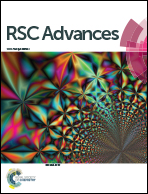Spectrofluorimetric determination of zearalenone using dispersive liquid–liquid microextraction coupled to micro-solid phase extraction onto magnetic nanoparticles†
Abstract
A new and sensitive method using dispersive liquid–liquid microextraction (DLLME) coupled to micro-solid phase extraction (μ-SPE) onto magnetic nanoparticles was developed for spectrofluorimetric determination of zearalenone (ZEN) in corn samples. In this study the solvent used to extract the analyte from a solid matrix, was then utilized as disperser solvent in the DLLME process. The DLLME was performed by injecting 3 mL of acetonitrile/water (8 : 2, v/v) (disperser) containing 320 μL of 1-heptanol (extraction solvent) into 30 mL of water sample. In the present DLLME-μ-SPE approach, hydrophobic magnetic nanoparticles were used to retrieve the extractant of 1-heptanol in the DLLME step. In fact the target of μ-SPE was the 1-heptanol rather than the ZEN. The ZEN was extracted from hydrophobic magnetic nanoparticles by stirring with 1 mL of acetonitrile for 4 min. Influential parameters affecting the extraction efficiency were investigated and optimized. Under the optimum conditions the calibration curve for ZEN determination showed good linearity in the range 0.51–300.0 μg L−1 (R2 = 0.9994) and the limit of detection (S/N = 3) was estimated to be 0.25 μg L−1. The intra-day and inter-day precision (RSD %) of ZEN were in the range of 2.7–4.1%. High recoveries ranging from 93.2 to 102.1% were obtained. The results demonstrated that the developed method is simple, inexpensive, accurate and remarkably free from interference effects. Also, this two-step method reclaimed the versatility of DLLME because the selection of the extraction solvent was not limited to the high density solvents.


 Please wait while we load your content...
Please wait while we load your content...